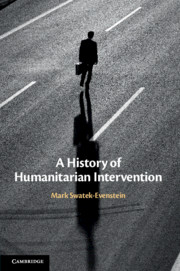Book contents
- A History of Humanitarian Intervention
- A History of Humanitarian Intervention
- Copyright page
- Epigraph
- Contents
- Acknowledgements
- Introduction
- 1 The Battlegrounds of a History of ‘Humanitarian Intervention’
- 2 A History of ‘Humanitarian Intervention’ in Nineteenth-Century International Law
- 3 ‘Humanitarian Intervention’ in the Era of the League of Nations
- 4 The World after 1945
- Bibliography
- Index
4 - The World after 1945
Published online by Cambridge University Press: 23 January 2020
- A History of Humanitarian Intervention
- A History of Humanitarian Intervention
- Copyright page
- Epigraph
- Contents
- Acknowledgements
- Introduction
- 1 The Battlegrounds of a History of ‘Humanitarian Intervention’
- 2 A History of ‘Humanitarian Intervention’ in Nineteenth-Century International Law
- 3 ‘Humanitarian Intervention’ in the Era of the League of Nations
- 4 The World after 1945
- Bibliography
- Index
Summary
On 26 July 1946, in court room 600 of the majestic ‘Palace of Justice’ (Justizpalast) in Nuremburg, Germany, Sir Hartley Shawcross (1902–2003), the British Chief prosecutor at the International Military Tribunal, presented his closing arguments on the 187th day in the case against the twenty-two high-ranking Nazi defendants, including Hermann Göring and Rudolf Hess. The British team had met with French professor René Cassin (1887–1976) in preparation for the landmark trial,1 and Shawcross’ speech had in large part been drafted by British law professor Hersch Lauterpacht, though he went off-script to include the charge of ‘genocide’, the term coined by Polish legal activist Raphael Lemkin (1900–1959).2 As the British case also covered the charges of ‘Crimes against Peace’, Shawcross’ arguments would have also touched upon the work of Soviet international law scholar Aron N. Trainin (1883–1957), author of ‘Hitlerite Responsibility under International Law’, a small pamphlet that apparently had been read by many in preparation for the trial in Nuremberg3 and which, uncharacteristically for Soviet discourse by the end of the war and after, was very explicit in its treatment of the Jewish identity of many of the victims of the Holocaust.4
Keywords
- Type
- Chapter
- Information
- A History of Humanitarian Intervention , pp. 202 - 240Publisher: Cambridge University PressPrint publication year: 2020



